 Technology peripherals
Technology peripherals
 AI
AI
 New work by Chen Danqi's team: Llama-2 context is expanded to 128k, 10 times throughput only requires 1/6 of the memory
New work by Chen Danqi's team: Llama-2 context is expanded to 128k, 10 times throughput only requires 1/6 of the memory
New work by Chen Danqi's team: Llama-2 context is expanded to 128k, 10 times throughput only requires 1/6 of the memory
The Chen Danqi team has just released a new LLMContext window extensionMethod:
It only uses 8k token documents for training, and can Llama-2 Window extended to 128k.
The most important thing is that in this process, the model only requires 1/6 of the original memory, and the model obtains 10 times the throughput.
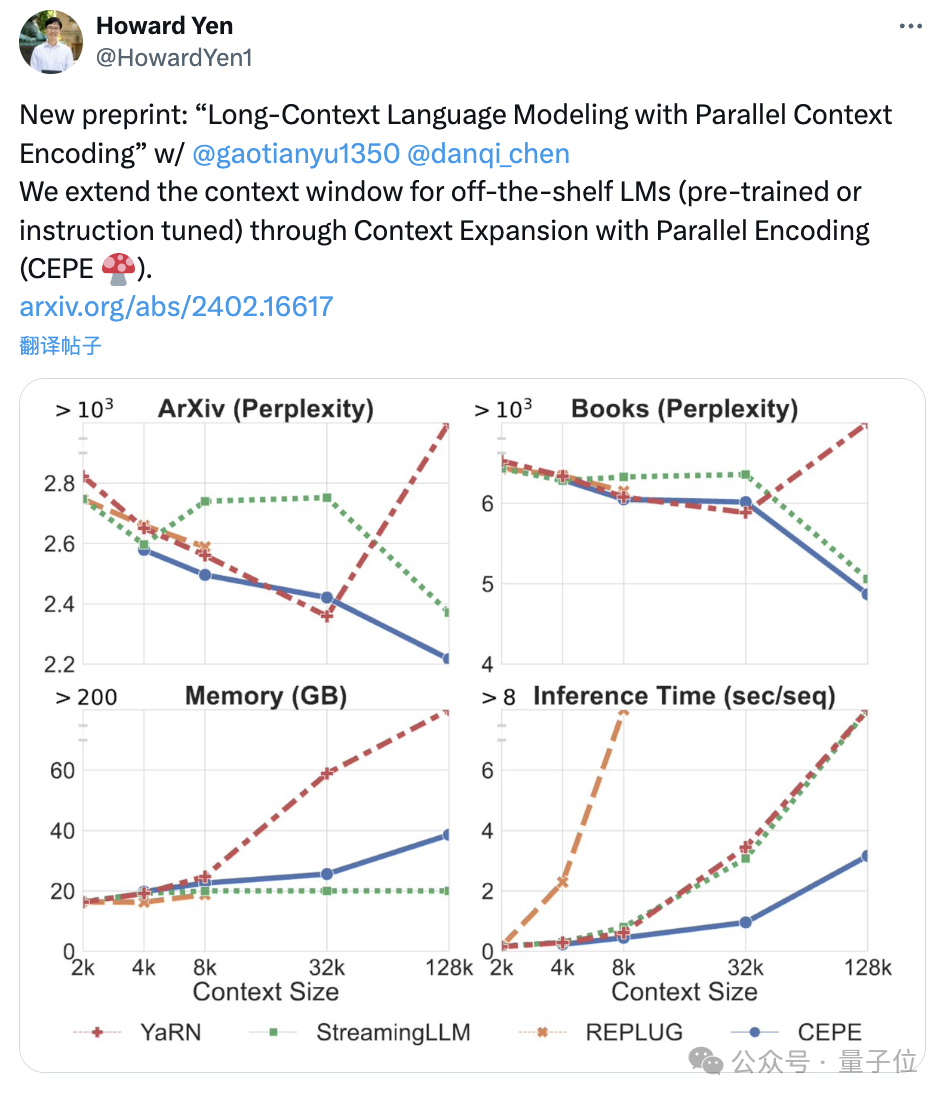
In addition, it can also greatly reduce the training cost:
Use this method to train 7B alpaca 2 For transformation, you only need a piece of A100 to complete it.
The team expressed:We hope this method will be useful and easy to use, and provideCurrently, the model and code have been released on HuggingFace and GitHub.cheap and effective long context capabilities for future LLMs.

CEPE, the full name is "Parallel Encoding Context Extension(Context Expansion with Parallel Encoding)”.
As a lightweight framework, it can be used to extend the context window of anypre-trained and directive fine-tuning model.
For any pretrained decoder-only language model, CEPE extends it by adding two small components:One is a small encoder for long The context is block-encoded;
One is the cross-attention module, which is inserted into each layer of the decoder to focus on the encoder representation.
The complete architecture is as follows: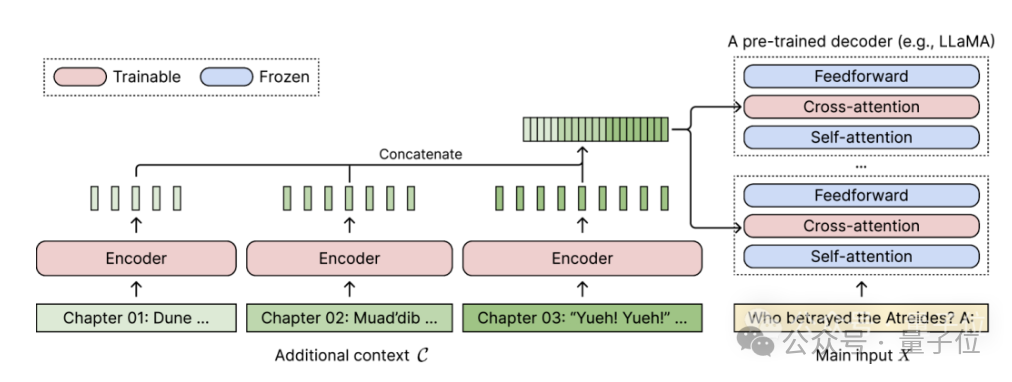
(1) The length can be generalized
because it is not subject to positional encoding A constraint, instead, has its context encoded in segments, each segment having its own positional encoding.(2) High efficiencyUsing small encoders and parallel encoding to process context can reduce computational costs.
(3) Reduce training cost
with a 400M encoder and cross-attention layer (a total of 1.4 billion parameters), it can be completed with an 80GB A100 GPU.
Perplexity continues to decreaseThe team applies CEPE to Llama-2 and trains on the filtered version of RedPajama with 20 billion tokens(only the Llama-2 pre-training budget 1%).
First, compared to two fully fine-tuned models, LLAMA2-32K and YARN-64K, CEPE achieves lower or comparableperplexity## on all datasets. #, with both lower memory usage and higher throughput.
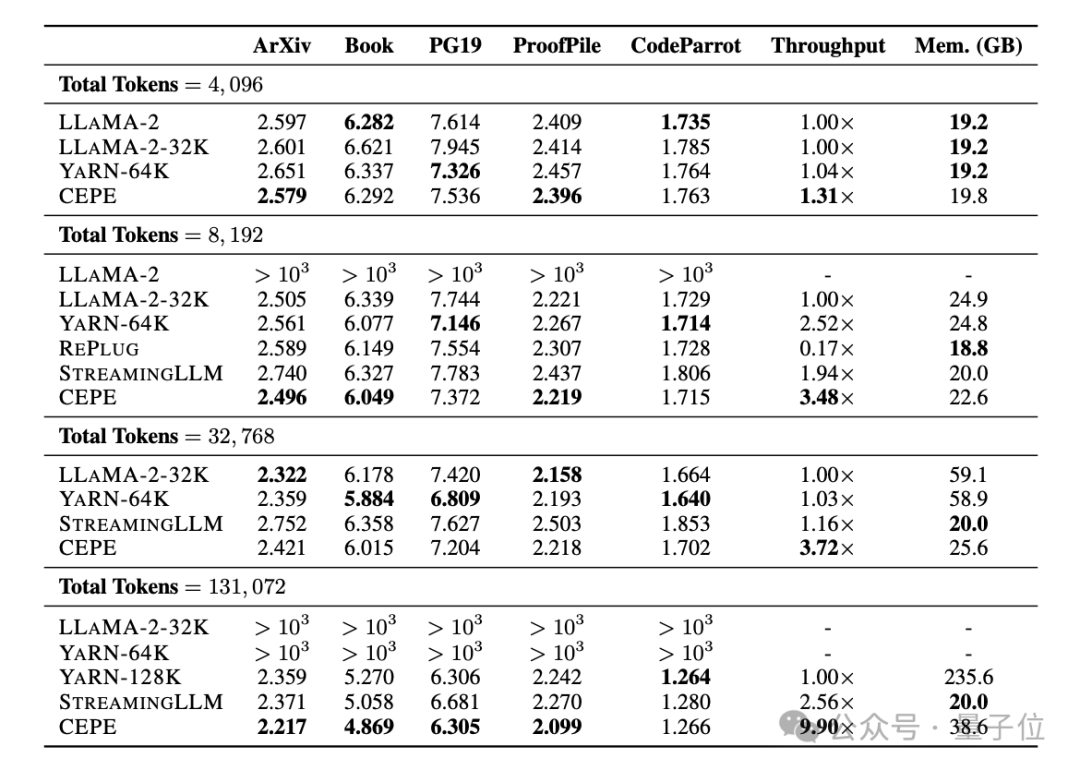 When the context is increased to 128k
When the context is increased to 128k
, CEPE’s perplexity continues to decrease while remaining low memory status. In contrast, Llama-2-32K and YARN-64K not only fail to generalize beyond their training length, but are also accompanied by a significant increase in memory cost.
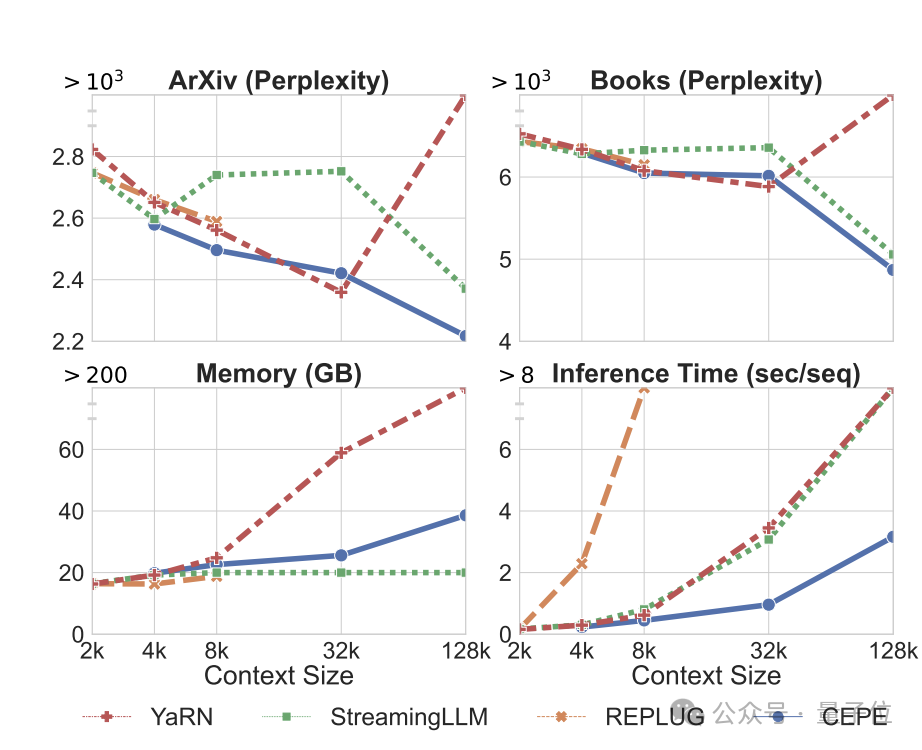 Secondly,
Secondly,
retrieval capability is enhanced. As shown in the following table:
By using the retrieved context, CEPE can effectively improve model perplexity, and its performance is better than RePlug.
It is worth noting that even if paragraph k=50 (training is 60), CEPE will continue to improve the perplexity.
This shows that CEPE transfers well to the retrieval enhancement setting, whereas the full-context decoder model degrades in this ability.
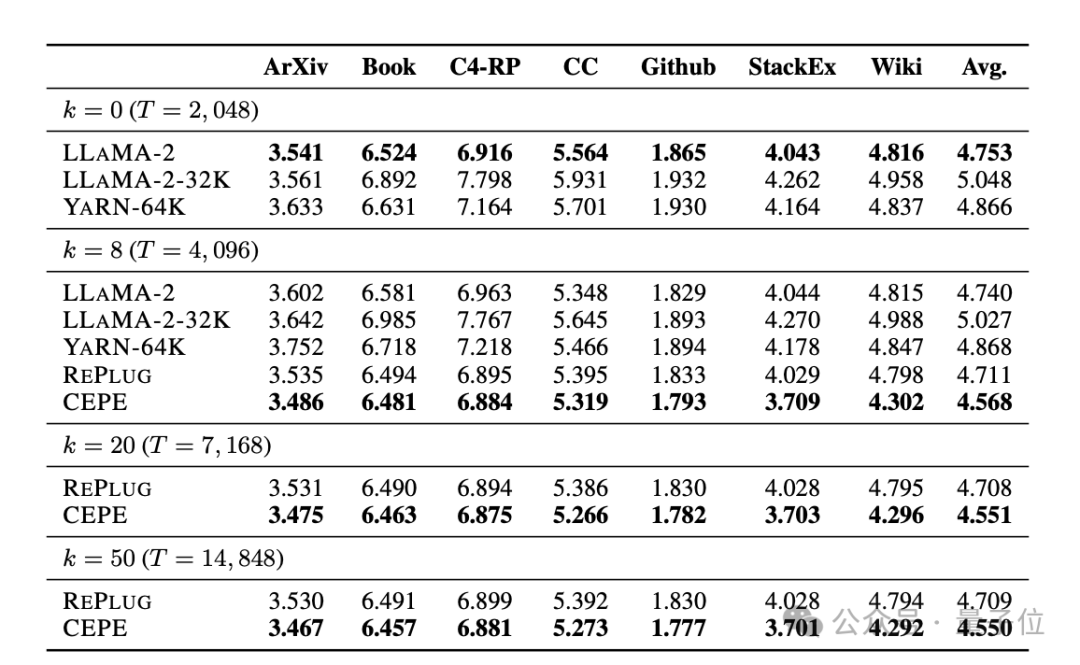
Third, open domain question and answer capabilitiesare significantly surpassed.
As shown in the figure below, CEPE is significantly better than other models in all data sets and paragraph k parameters, and unlike other models, the performance drops significantly as the k value becomes larger and larger.
This also shows that CEPE is not sensitive to a large number of redundant or irrelevant paragraphs.

So to summarize, CEPE outperforms on all the above tasks with much lower memory and computational cost compared to most other solutions.
Finally, based on these, the author proposed CEPE-Distilled (CEPED) specifically for the instruction tuning model.
It uses only unlabeled data to expand the context window of the model, distilling the behavior of the original instruction-tuned model into a new architecture through assisted KL divergence loss, thereby eliminating the need to manage expensive long context instruction tracking data.
Ultimately, CEPED can expand the context window of Llama-2 and improve the long text performance of the model while retaining the ability to understand instructions.
Team Introduction
CEPE has a total of 3 authors.
Yan Heguang(Howard Yen) is a master's student in computer science at Princeton University.
The second person is Gao Tianyu, a doctoral student at the same school and a bachelor's degree graduate from Tsinghua University.
They are all students of the corresponding author Chen Danqi.

Original paper: https://arxiv.org/abs/2402.16617
Reference link: https://twitter. com/HowardYen1/status/1762474556101661158
The above is the detailed content of New work by Chen Danqi's team: Llama-2 context is expanded to 128k, 10 times throughput only requires 1/6 of the memory. For more information, please follow other related articles on the PHP Chinese website!

Hot AI Tools

Undresser.AI Undress
AI-powered app for creating realistic nude photos

AI Clothes Remover
Online AI tool for removing clothes from photos.

Undress AI Tool
Undress images for free

Clothoff.io
AI clothes remover

Video Face Swap
Swap faces in any video effortlessly with our completely free AI face swap tool!

Hot Article

Hot Tools

Notepad++7.3.1
Easy-to-use and free code editor

SublimeText3 Chinese version
Chinese version, very easy to use

Zend Studio 13.0.1
Powerful PHP integrated development environment

Dreamweaver CS6
Visual web development tools

SublimeText3 Mac version
God-level code editing software (SublimeText3)

Hot Topics
 1664
1664
 14
14
 1423
1423
 52
52
 1321
1321
 25
25
 1269
1269
 29
29
 1249
1249
 24
24
 How to use the chrono library in C?
Apr 28, 2025 pm 10:18 PM
How to use the chrono library in C?
Apr 28, 2025 pm 10:18 PM
Using the chrono library in C can allow you to control time and time intervals more accurately. Let's explore the charm of this library. C's chrono library is part of the standard library, which provides a modern way to deal with time and time intervals. For programmers who have suffered from time.h and ctime, chrono is undoubtedly a boon. It not only improves the readability and maintainability of the code, but also provides higher accuracy and flexibility. Let's start with the basics. The chrono library mainly includes the following key components: std::chrono::system_clock: represents the system clock, used to obtain the current time. std::chron
 How to understand DMA operations in C?
Apr 28, 2025 pm 10:09 PM
How to understand DMA operations in C?
Apr 28, 2025 pm 10:09 PM
DMA in C refers to DirectMemoryAccess, a direct memory access technology, allowing hardware devices to directly transmit data to memory without CPU intervention. 1) DMA operation is highly dependent on hardware devices and drivers, and the implementation method varies from system to system. 2) Direct access to memory may bring security risks, and the correctness and security of the code must be ensured. 3) DMA can improve performance, but improper use may lead to degradation of system performance. Through practice and learning, we can master the skills of using DMA and maximize its effectiveness in scenarios such as high-speed data transmission and real-time signal processing.
 How to handle high DPI display in C?
Apr 28, 2025 pm 09:57 PM
How to handle high DPI display in C?
Apr 28, 2025 pm 09:57 PM
Handling high DPI display in C can be achieved through the following steps: 1) Understand DPI and scaling, use the operating system API to obtain DPI information and adjust the graphics output; 2) Handle cross-platform compatibility, use cross-platform graphics libraries such as SDL or Qt; 3) Perform performance optimization, improve performance through cache, hardware acceleration, and dynamic adjustment of the details level; 4) Solve common problems, such as blurred text and interface elements are too small, and solve by correctly applying DPI scaling.
 What is real-time operating system programming in C?
Apr 28, 2025 pm 10:15 PM
What is real-time operating system programming in C?
Apr 28, 2025 pm 10:15 PM
C performs well in real-time operating system (RTOS) programming, providing efficient execution efficiency and precise time management. 1) C Meet the needs of RTOS through direct operation of hardware resources and efficient memory management. 2) Using object-oriented features, C can design a flexible task scheduling system. 3) C supports efficient interrupt processing, but dynamic memory allocation and exception processing must be avoided to ensure real-time. 4) Template programming and inline functions help in performance optimization. 5) In practical applications, C can be used to implement an efficient logging system.
 How to measure thread performance in C?
Apr 28, 2025 pm 10:21 PM
How to measure thread performance in C?
Apr 28, 2025 pm 10:21 PM
Measuring thread performance in C can use the timing tools, performance analysis tools, and custom timers in the standard library. 1. Use the library to measure execution time. 2. Use gprof for performance analysis. The steps include adding the -pg option during compilation, running the program to generate a gmon.out file, and generating a performance report. 3. Use Valgrind's Callgrind module to perform more detailed analysis. The steps include running the program to generate the callgrind.out file and viewing the results using kcachegrind. 4. Custom timers can flexibly measure the execution time of a specific code segment. These methods help to fully understand thread performance and optimize code.
 Quantitative Exchange Ranking 2025 Top 10 Recommendations for Digital Currency Quantitative Trading APPs
Apr 30, 2025 pm 07:24 PM
Quantitative Exchange Ranking 2025 Top 10 Recommendations for Digital Currency Quantitative Trading APPs
Apr 30, 2025 pm 07:24 PM
The built-in quantization tools on the exchange include: 1. Binance: Provides Binance Futures quantitative module, low handling fees, and supports AI-assisted transactions. 2. OKX (Ouyi): Supports multi-account management and intelligent order routing, and provides institutional-level risk control. The independent quantitative strategy platforms include: 3. 3Commas: drag-and-drop strategy generator, suitable for multi-platform hedging arbitrage. 4. Quadency: Professional-level algorithm strategy library, supporting customized risk thresholds. 5. Pionex: Built-in 16 preset strategy, low transaction fee. Vertical domain tools include: 6. Cryptohopper: cloud-based quantitative platform, supporting 150 technical indicators. 7. Bitsgap:
 Steps to add and delete fields to MySQL tables
Apr 29, 2025 pm 04:15 PM
Steps to add and delete fields to MySQL tables
Apr 29, 2025 pm 04:15 PM
In MySQL, add fields using ALTERTABLEtable_nameADDCOLUMNnew_columnVARCHAR(255)AFTERexisting_column, delete fields using ALTERTABLEtable_nameDROPCOLUMNcolumn_to_drop. When adding fields, you need to specify a location to optimize query performance and data structure; before deleting fields, you need to confirm that the operation is irreversible; modifying table structure using online DDL, backup data, test environment, and low-load time periods is performance optimization and best practice.
 How to use string streams in C?
Apr 28, 2025 pm 09:12 PM
How to use string streams in C?
Apr 28, 2025 pm 09:12 PM
The main steps and precautions for using string streams in C are as follows: 1. Create an output string stream and convert data, such as converting integers into strings. 2. Apply to serialization of complex data structures, such as converting vector into strings. 3. Pay attention to performance issues and avoid frequent use of string streams when processing large amounts of data. You can consider using the append method of std::string. 4. Pay attention to memory management and avoid frequent creation and destruction of string stream objects. You can reuse or use std::stringstream.



